IN THIS REPORT
PLEASE READ DISCLOSURES & DISCLAIMER
Disclosure: Owners, members, directors and employees of Carboncredits.com have/may have stock or option position in any of the companies mentioned: LIFT. Carboncredits.com receives compensation for this publication and has a business relationship with any company whose stock(s) is/are mentioned in this article. This content was reviewed and approved by LIFT POWER.
The Fastest Developing North American Lithium Junior
As you may already know, one of the hottest resources in the coming decade will be lithium.
One of the most essential ingredients in the production of batteries, lithium powers some of the most important devices in our everyday lives:
- Smartphones,
- Tablets and laptop computers,
- Wireless earbuds and other wearables
- Energy storage, and
- Electric vehicles (EVs).
As you can see in the chart below, the demand for lithium is expected to take off over the next decade.
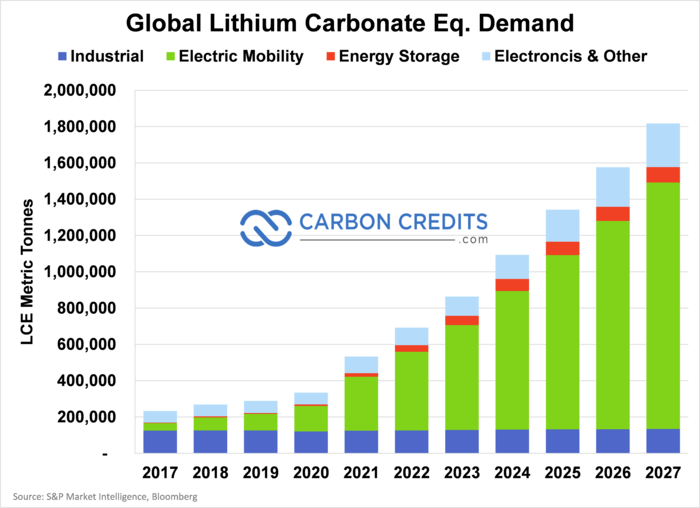
EVs, in particular, have already become the leading source of demand for lithium since 2019. This gap will only widen further as we close in on the 2030-2040 decade, when bans on combustion engine vehicle sales will be rolling out across most advanced nations.
Over 50 countries have plans to ban new sales of gasoline-powered vehicles by 2040 at the latest including: China, India, Japan, South Korea, Canada, the U.K., and most of the Eurozone.
Combined, these countries shifting towards low- or zero-emissions vehicles represent over half of the world’s total population.
And what those new vehicles will all need… is lithium.
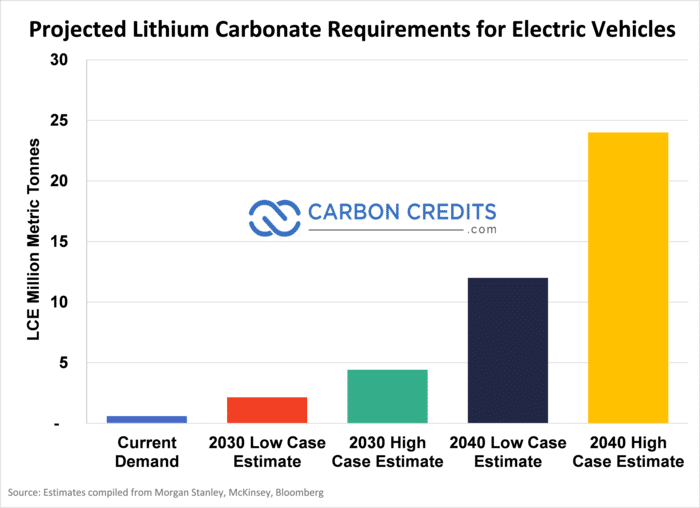
Lithium demand is projected to at least double by the end of the decade, following currently stated political commitments and ambitions from auto manufacturers.
In order for the world to stay on track with the ideal sustainable development scenario, however, the world will need to transition much more aggressively towards electric vehicles.
- To meet the goals of the Paris Agreement and keep global warming below 2° Celsius, lithium demand would need to quintuple by 2030, and grow nearly 12x by 2040.
- Morgan Stanley stated lithium requirements could be up to 40x current demand by 2040. McKinsey estimates 20-30% growth every year for a decade or more.
Even if we end up in the “low case” caused by tough economic conditions and lower incentives to auto manufacturers, lithium demand should still be multiples of current demand.
So, we know that the demand for lithium will be there. But how does the supply side of things look?
Things Look Rosy… For Now
In the short term, large amounts of lithium supply are expected to come online from Australia, Chile, and China – the world’s three largest producers – and this projected surplus is expected to keep lithium prices in check for most of 2024.

Looking past the next 12-24 months, the story rapidly changes.
Analysts at industry research firm BMI, for instance, are expecting China’s lithium demand from EV’s alone to grow at a pace of 20.4% every year from now until 2032.
In that same timeframe, however, China’s lithium supply is only projected to increase by 6% annually – less than a third of the rate of forecast demand growth.
Fellow research firm comes up with a similar picture, shown below is the lithium production and surplus/deficit forecast through the next decade.
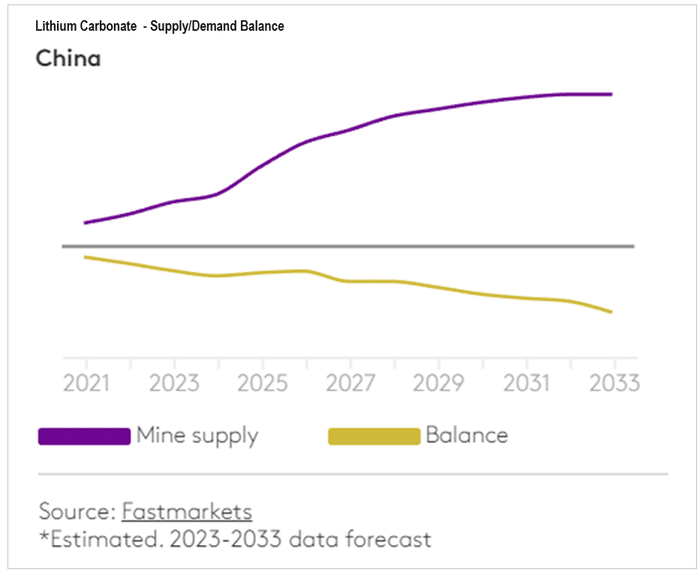
Any way you slice it, China and the world appear to be heading for a major deficit over the next decade.
Unsurprisingly, China is also the world’s leading consumer of lithium on top of being the world’s third largest producer. Roughly 40% of all mined lithium currently ends up in Chinese processing plants, which account for over two-thirds of all lithium processing capacity worldwide.
Most of this lithium ends up in the form of lithium-ion batteries that get sent to other places, like the U.S. or the Eurozone. But if China can’t keep up with its own demand for lithium, supply is going to dry up for every other country.
- Australia might produce half of the world’s lithium… but over 95% of that lithium goes straight to China.
As the cornerstone of the EV revolution and clean energy transition, lithium was one of several elements designated by President Joe Biden as a “critical mineral”.
“China controls most of the global market in these minerals… We can’t build a future that’s made in America if we ourselves are dependent on China for the materials that power the products of today and tomorrow.” – President Biden
In other words, the U.S. wants to look closer to home for its supply of the vitally important white metal.
And that means North America, where friendly neighbors like Canada – which already exports over 50% of all its mined minerals across the 49th parallel – exist.
Red and White to Solve Your Lithium Blues
Despite being the world’s eighth largest producer of lithium, Canada is a very small fish in the pond when compared to the heavyweights like Australia and Chile.
But while its current production may not impress, its reserves are sizeable.
- Canada boasts the sixth largest reserves of lithium in the world – just under half the size of China’s at 930,000 tonnes.
However, in 2023 Canada mined just 3,400 tonnes of lithium, a mere fraction of global supply.
If You Build it, They Will Come
With the recently passed mandate that indicates auto OEMs won’t qualify for subsidies and incentives if they use foreign lithium, the US is in a huge pinch. Domestically there aren’t enough lithium reserves to meet demand, so it seems likely that “friends of the USA” such as Canada can chip in to meet the US lithium requirements.
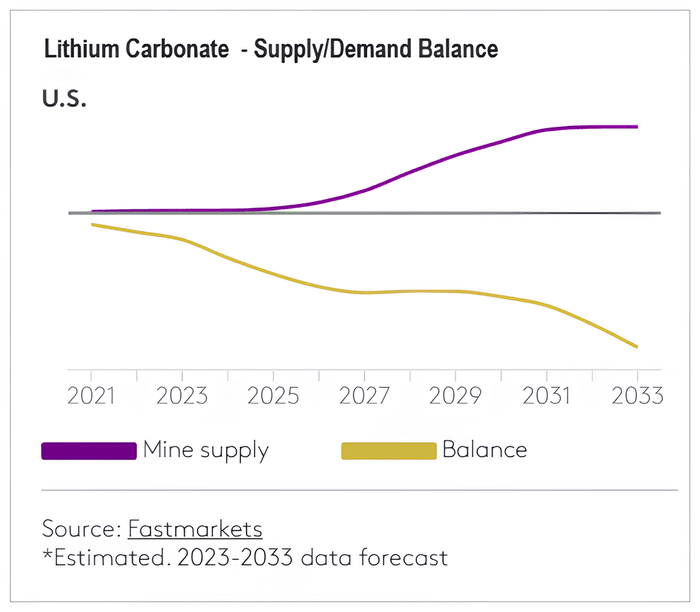
With just a paltry 3,400 tonnes of production, clearly, there’s much potential for growth here. And that’s why one particularly savvy junior lithium company has snatched up some extremely promising, high-quality lithium assets in the Great White North.
Named Li-FT Power, this company just started drilling their flagship project last June – but are already targeting a maiden resource estimate for this August, and even a Preliminary Economic Assessment (PEA) for December.
Right now, the company is all gas no brakes as it’s speeding through the project exploration and development stage as fast as possible. The management team at Li-FT knows that we might already be facing a lithium shortage by next year…
… and when that time comes, it’s the most high-grade, advanced stage North American projects that will be getting the most premium valuations.
So, let’s take a closer look at Li-FT to see just why they’re one of the companies best prepared to take advantage of the looming lack of lithium. For this, we’ll whip out our trusty old acronym, P.R.O.F.I.T., to break down each aspect of the company’s business.
Li-FT Power Ltd.
(TSX-V: LIFT | US: LIFFF)
[P]eople
The team at Li-FT is led by CEO and Director Francis MacDonald, a longtime veteran of the mining industry. An exploration geologist by trade, MacDonald spent much of his career with his boots on the ground for Newmont, the world’s largest gold mining company.
With his specialized focus on finding and assessing greenfield (early exploration stage) projects, MacDonald knows what the best assets look like before they get turned into successful mines. And those top projects are exactly what he’s managed to lock down for Li-FT.
Backing up MacDonald’s mining expertise is President and Director Alex Langer, formerly VP of Capital Markets at Canaccord Genuity.
With over 100 deals funded in the mining and technology sectors, Langer was notably central to the success of Millennial Lithium, which was bought out by Lithium Americas back in 2022 for half a billion dollars. He also has experience serving on the management team of other junior miners like Sierra Madre, making him an excellent complement to MacDonald’s skillset.
Last but not least, Director Iain Scarr rounds out Li-FT’s roster of mining veterans. As the founder of IMEX Consultants, a consulting firm for the industrial metals sector, Scarr has spent over four decades in the mining industry.
That includes a 30-year stint with Rio Tinto, the second-largest mining company globally, as Commercial Director and VP of Exploration. His resume includes taking three different lithium projects from grassroots exploration all the way up to the feasibility study stage before they were acquired. Scarr’s hands-on experience with growing lithium projects through to the development stage is exactly what Li-FT needs.
With the combination of MacDonald’s geological know-how, Langer’s capital markets expertise, and Scarr’s mining development experience (particularly with lithium projects), Li-FT has a well-rounded management team that’s perfectly set up to lead the company to success.
Now that we know who’s in charge, let’s take a look at the other elements key to Li-FT’s success.
[R]esources
The most important resource for an exploration-stage mining company isn’t actually a resource estimate. Rather, it’s cash – because without funding, a junior mining company won’t be able to drill its properties or acquire new ones, let alone establish an initial resource estimate.
While Li-FT doesn’t have a maiden resource estimate yet, it does have plenty of capital – CAD$7 million in cash without any outstanding long-term debt, thanks to an oversubscribed flow-through offering that they carried out just this past March.
With its current exploration programs already fully paid for (more on that later), Li-FT Power is fully cashed up and in a very healthy position to continue its development work.
They won’t need to go back to the markets to raise more capital anytime soon. On top of that, when they do eventually need to, they’ll have the connections in place to raise whatever amount they need, as evidenced by how their most recent financing took place just four months after their previous oversubscribed one.
Now, let’s discuss those exploration programs we mentioned earlier.
[O]perations
Li-FT has five different projects spread across three different areas, all located in the extremely safe and friendly mining jurisdiction of Canada:
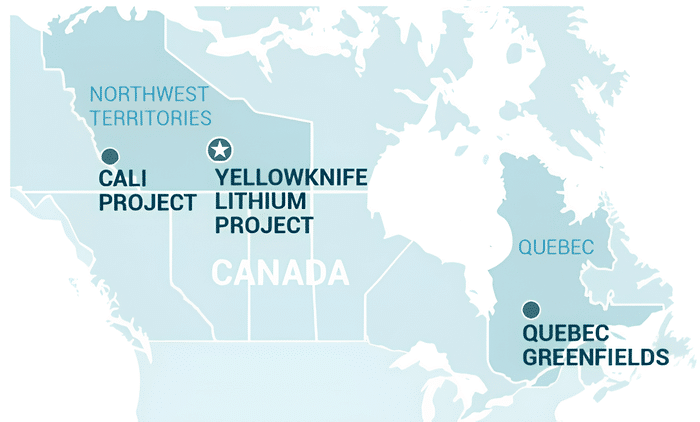
The company’s flagship project, their 100%-owned Yellowknife Lithium project, is located near the capital city of the same name in the Northwest Territories.
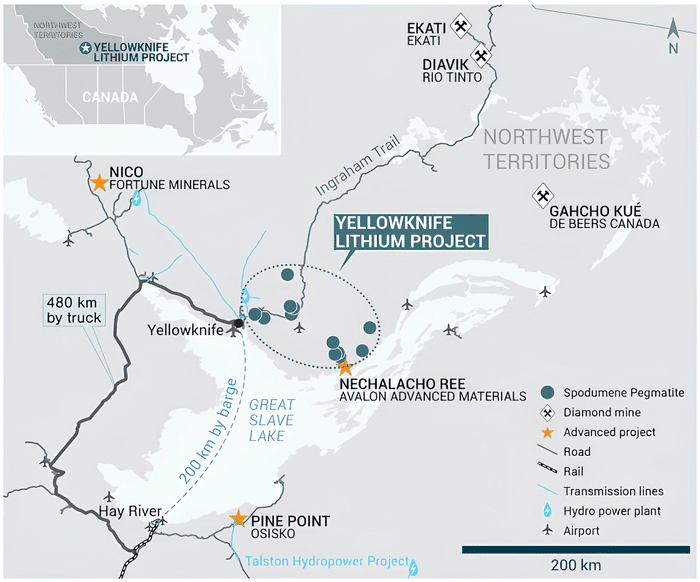
Combined, the claims that make up the project cover several prominent lithium pegmatite outcroppings with visible mineralization. Just on the surface alone, strike lengths of up to 40 meters in width and 1,800 meters in length are visible, extending up to a total strike length of 10 kilometers within the project area.
- Numerous high-grade drill intersects have been logged from multiple zones, with results averaging between 1-1.5% lithium over intervals up to 80 meters long:

50,000m of drilling took place at the Yellowknife Lithium project over the last few months of 2023 and the first half of 2024. A maiden resource estimate is expected by late summer of this year, with a PEA to follow by year-end.
Li-FT’s extremely aggressive exploration program is on track to take Yellowknife from initial drill program to PEA in just 18 months – a breakneck pace that’s nearly unheard of in the mining industry. The management team knows exactly the best way to unlock the Yellowknife Lithium project’s value, and they’re executing their game plan with laser-sharp focus.
With most of the project’s mineral leases located within 60 km of its namesake city of Yellowknife, road and infrastructure access is excellent. Rail connection is available at Hay River on the southern shore of Great Slave Lake, accessible from Yellowknife by either barge or all-weather road.
Yellowknife Lithium has the grades and size to potentially be one of the largest hard-rock lithium projects in all of North America. Fittingly, it’s also Li-FT’s flagship and most advanced stage project.
Completion of the resource estimate and other work such as environmental and metallurgical studies will continue through 2024, and the PEA anticipated in December should be a strong catalyst for the company.

Next up we have the Cali project, located not in California as you might expect but rather on the western border of the Northwest Territories, near the Yukon Territory.
Acquired alongside the Yellowknife Lithium project, Cali is a much earlier stage project than the former. Surface exploration work was carried out last year, and permitting is currently under way to allow for an initial exploratory drilling program that’s planned to begin this summer.
Located 50 km north of the Cantung mine, one of the world’s largest tungsten deposits outside of China, road access is just 6 km away, though other infrastructure is more lacking in comparison to Yellowknife Lithium.

Last but not least we have a trio of greenfield exploration projects that make up the remainder of Li-FT’s portfolio.
All located in the James Bay area of Quebec, these three projects are also targeting lithium-bearing pegmatites like those found at Yellowknife Lithium and Cali, though the ones here are under cover and not surface outcroppings like the latter.
- Notably, these projects are all located near other sizeable high-grade hard-rock lithium projects.
To the southeast, the Rupert project surrounds the Whabouchi lithium mine, which contains a measured & indicated 37.4 million tonnes of 1.48% lithium oxide and is expected to produce 3,000 tonnes per day over a 26-year mine life. Currently under construction, production is planned to begin at Whabouchi in 2025.
A 5,000-meter drilling program that began at Rupert last March is almost complete. Extensive sampling has produced 7 other areas that will be targeted for follow-up work later this year.
Much of the Rupert project contains geology similar to what’s present at the Whabouchi mine, and infrastructure access in the area is excellent. There are plenty of targets at Rupert awaiting further exploration.
The two other projects, Pontax and Moyenne, are located to the west of Rupert. They're geologically similar to the nearby James Bay mine project that holds 110 million tonnes of 1.3% lithium oxide and is expected to produce 5,400 tonnes per day over a 15-20 year mine life.
A highway runs through the middle of Pontax allowing for easy access and a summer 2023 surface exploration program carried out there identified a major 13 km by6 km spodumene anomaly. This is similar in size to the nearby Whabouchi deposit, and Pontax will see further follow-up work later this year to delineate drill targets.
While the three Quebec assets all provide further exploration upside potential to Li-FT, none of them are a focus for the company right now.
To put the potential value of those assets into perspective, Critical Elements which owns the Rose project just to the north of Li-FT’s assets currently has a valuation of $140M. There will be numerous creative ways for Francis and the team to unlock value with respect to the Quebec assets.
[F]uture
Currently, Li-FT’s primary focus is their flagship Yellowknife Lithium asset.
The first major catalyst along the way would be the initial resource estimate at Yellowknife, which is currently expected to be completed by early August. A strong resource estimate would provide lots of reasons for investors to get excited about the company and would support a more positive result from the PEA in December, which would be the next catalyst.
If all goes well, Li-FT will likely focus on developing their Yellowknife project into a producing mine or attract the attention of somebody bigger looking to do the same thing.
While further exploration work is also continuing at Cali and Pontax, those two projects, alongside Rupert and Moyenne, can be considered bonus kickers on top of Yellowknife.
As the most advanced stage project with the most potential, barring any new acquisitions, upcoming results from Yellowknife will provide the majority of the driving force behind Li-FT’s valuation for 2024.
On the subject of the company’s valuation, let’s take a look at the paper backing the company to make sure everything’s good on that front.
[I]nvestors

Li-FT has an impressively tightly held share structure. Management and other insiders own 58% of the stock with institutions taking up another 17%, leaving just 25% for retail investors.
There’s very little option overhang as well, which is always good to see as it means that management isn’t patting themselves on the back too much with excessive share-based compensation.
Thanks to its tight ownership, Li-FT’s stock sees fairly low volatility and its share price has traded in a fairly tight band since its last capital raise that took place alongside its initial Canadian listing.
With so much of the float locked up by management, insiders, and institutional shareholders, the goals of Li-FT’s executive team are very closely aligned with that of the retail shareholders. It means that management believes in their own company and are putting their money where their mouth is – a very positive sign.
[T]riggers
As we discussed earlier, while this year may be a quiet one for lithium, the supply deficit is expected to widen as we near 2030 and more countries take on stricter climate commitments.
Though the lithium shortage may still be years away, the team at Li-FT aren’t taking any chances. Building a mine is a process that can take up to a decade or even longer, and management wants to be 100% certain that the Yellowknife Lithium project will be ready to go – or as close to it as possible – when the supply shortfall hits.
Like we previously mentioned, the maiden resource estimate at Yellowknife followed by the PEA will be the two key developments to watch out for this year.
Past that, further exploration and drilling at Cali and Pontax also have the potential to provide significant upside to the stock.
The Pontax asset, in particular, hosts an anomaly very similar to a nearby world-class lithium deposit that is already being built into a mine. With the company planning to define drill targets at Pontax later this year, positive results from drilling there down the line would be exciting for the stock and would incentivize the additional work needed to really make Li-FT's greenfield projects shine.
Right now, the lithium markets are experiencing the calm before the storm. With several delayed projects coming online and new EV sales still recovering from the high inflation, high interest rate environment of last year, 2024 might even see an excess of lithium supply.
However, with the unstoppable advance of the EV revolution, that situation won’t last for long. And when the time inevitably comes that the markets need a solution to the world’s insatiable appetite for the white metal, Li-FT Power will be perfectly positioned to take advantage.
For Direct Information from LiFT Power, please visit their Investors Center.
LATEST NEWS

DISCLOSURES/DISCLAIMER
Investing in stocks is HIGH RISK. You could lose All of your investment.
Carboncredits.com, as a publisher, is not a broker, investment advisor, or financial advisor in any jurisdiction.
Please do not rely on the information presented by Carboncredits.com as personal investment advice.
If you need personal investment advice, kindly reach out to a qualified and registered broker, investment advisor, or financial advisor.
The communications from Carboncredits.com should not form the basis of your investment decisions. Examples we provide regarding share price increases related to specific companies are based on randomly selected time periods and should not be taken as an indicator or predictor of future stock prices for those companies.
Lift Power has sponsored this report.
The information in this newsletter does not constitute an offer to sell or a solicitation of an offer to buy any securities of a corporation or entity, including U.S. Traded Securities or U.S. Quoted Securities, in the United States or to U.S. Persons. Securities may not be offered or sold in the United States except in compliance with the registration requirements of the Securities Act and applicable U.S. state securities laws or pursuant to an exemption therefrom.
Any public offering of securities in the United States may only be made by means of a prospectus containing detailed information about the corporation or entity and its management as well as financial statements. No securities regulatory authority in the United States has either approved or disapproved of the contents of any newsletter. Carboncredits.com nor any employee of Carboncredits.com is not registered with the United States Securities and Exchange Commission (the “SEC”): as a “broker-dealer” under the Exchange Act, as an “investment adviser” under the Investment Advisers Act of 1940, or in any other capacity.
Carboncredits.com, its owners, directors, and employees are also not registered with any state securities commission or authority as a broker-dealer or investment advisor or in any other capacity.
HIGHLY BIASED:
In our role, we aim to highlight specific companies for your further investigation; however, these are not stock recommendations, nor do they constitute an offer or sale of the referenced securities. Carboncredits.com has received cash compensation from Lift Power and is thus extremely biased. It is crucial that you conduct your own research prior to investing. This includes reading the companies’ SEDAR and SEC filings, press releases, and risk disclosures. The information contained in our profiles is based on data provided by the companies, extracted from SEDAR and SEC filings, company websites, and other publicly available sources.
Carboncredits.com, and its directors, employees, and members of their households directly own or may own shares of Lift Power. Therefore, Carboncredits.com is extremely biased. Measures are in place such that no shares will be sold during the active awareness campaign.
HIGH RISK:
The securities issued by the companies we feature should be seen as high risk; if you choose to invest, despite these warnings, you may lose your entire investment. You must be aware of the risks and be willing to accept them in order to invest in financial instruments, including stocks, options, and futures.
NOT PROFESSIONAL ADVICE:
By reading this, you agree to all of the following: You understand this to be an expression of opinions and NOT professional advice. You are solely responsible for the use of any content and hold Carboncredits.com, and all partners, members, and affiliates harmless in any event or claim. While Carboncredits.com strives to provide accurate and reliable information sourced from believed-to-be trustworthy sources, we cannot guarantee the accuracy or reliability of the information. The information provided reflects conditions as they are at the moment of writing and not at any future date. Carboncredits.com is not obligated to update, correct, or revise the information post-publication.
FORWARD-LOOKING STATEMENTS:
Certain information presented may contain or be considered forward-looking statements. Such statements involve known and unknown risks, uncertainties, and other factors that may cause actual results or events to differ materially from those anticipated in these statements. There can be no assurance that any such statements will prove to be accurate, and readers should not place undue reliance on such information. Carboncredits.com does not undertake any obligations to update the information presented or to ensure that such information remains current and accurate.

